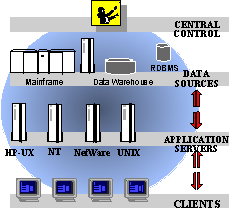
- Scalable
- Expandable and Flexible
- Tuned for Performance
- Protects All Mission-Critical Data
- Resilient
- Manageable

Joan Klenske
Legato Systems, Inc.
3210 Porter Drive
Palo Alto, CA 94304
Phone: (650) 812-6000
Fax: (640) 812-6032
E-mail: jklenske@legato.com
Executive Summary
Data protection poses a challenge for today's enterprises. Companies have evolved into heterogeneous computing environments, with vast amounts of mission-critical data. In addition, enterprises are faced with the reality of high transaction, 24x7 shops, which require on-line backup and high performance storage management. In order to manage these backups, IT managers require tape library / media management solutions, such as autochangers. Finally, IT professionals in the enterprise arena are looking for a flexible, scalable architecture with the ability to manage from a central location in an often decentralized environment.
If all of these needs sound painfully familiar, it is because these areas also represent challenges for HP 3000 enterprises. The HP 3000 mission-critical computing environment has evolved into a heterogeneous one, often including both HP-UX and/or NT platforms. Finding a comprehensive storage management solution that treats all of these platforms as a single enterprise has become increasingly difficult. In addition, these environments require on-line 24x7 backup and tape library / media management solutions such as autochangers.
This paper will introduce and discuss a storage management architecture that can meet ALL these requirements. Its components include the performance capabilities of a storage node (which resides in the centrally managed data zone, and rises to the global capabilities of the control zone) providing centralized management for today's decentralized / remote needs. A case study provides a real-life example of this architecture at work, and illustrates how a complete enterprise storage management solution fulfills the needs of the HP 3000 enterprise environment.
The HP 3000 Environment
Background information
HP 3000 environments are evolving into heterogeneous enterprises. As these environments grow, so do their storage management requirements. In the not so distant past, HP 3000 data centers were the central point of IT operations. This model is shifting, or more accurately, becoming a component of a larger model, the enterprise. As part of this larger model, the data center has its own needs, which must be balanced with the bigger picture- the constantly evolving needs of the enterprise.
Data centers
Data centers are an important component of the enterprise. They generally consist of mission-critical, application-specific data stored on large databases and file servers. This certainly is the case with HP 3000s, which are still primarily used for commercial online transaction processing (OLTP). Data volumes for this application can reach several hundred terabytes. Dedicated backup of these servers has traditionally been required for reasons of corporate policy or to fit an available backup window.
The computing infrastructures of HP 3000 mid-sized organizations were built on this computing platform with other operating systems added as extensions of the MPE environment. These include UNIX with Windows NT and/or NetWare servers providing data, application, file and printing services. In this environment, customers needed a backup strategy that was both flexible, to protect all servers with equal efficiency, and centralized, to allow the backup of all departmental servers to a "glass house". Either way, central administration was required.
Data center needs are important to the enterprise, since the HP 3000, OLTP applications are increasingly critical to its success. If the application stops, the business stops. Because of this, such applications still need high availability systems that are protected from planned and unplanned operational functions. This, in turn, means that an enterprise solution must still deliver high availability, online backup, and the support of advanced media management. Once the data center's needs are addressed, we can move on to the needs of the enterprise.
Storage management challenges
In defining an enterprise, we will gain a better understanding of the challenges that many companies are faced with, and what new storage management needs they must consider. Companies are now relying on client/server and mainframe computing; a mix of virtually every computing platform; a combination of LAN, WAN, intranet, and Internet technology; and the use of commercial network management frameworks for centralized administration.
WEB technology has fundamentally changed corporate computing. With an Intranet, data is dispersed on many servers in a large heterogeneous network, allowing companies more options for a global presence. Companies are becoming overwhelmed with the large amounts of data that they need to protect, within increasingly smaller windows of time. Data quantities are now easily exceeding the terabyte and larger range, and as companies move toward 7x24 operations, the time needed to backup this mission-critical data is shrinking. In addition, companies now consist of networks of data centers, adding to the complexity of the storage management challenge.
Trends in data protection
Consequently, an emerging trend in data protection is the use of centralized backup management in order to enforce consistency and control of storage distributed over the enterprise. This form of centralized management is usually run by a company's corporate IT group. With decentralized operations at each data center, individual sites or offices can set specific backup schedules and environment-specific rules. This allows corporate IT groups to focus solely on ensuring that the enterprise data is protected consistently, while local sites manage their own backup operations. To support this model, WEB technologies, especially Java applets and Active-X controls, been used to develop browser-based applications capable of remotely controlling the backup processes.
Another important trend in this emerging enterprise storage management market, is the lack of IT skills customers or end-users exhibit. With a shortage of skilled people in many IT organizations, each IT staff member is responsible for managing more servers or networks. Consequently, the internal IT staff does not have time to learn about managing an enterprise backup system and often relies heavily on support and consulting services. Companies now demand 24x7 support and on-site consulting for new installations.
Criteria for a Total Solution
Since storage management has been elevated to a strategic, business-critical function, companies need more than just a product. Enterprises today look for a total storage management solution that offers a complete architecture to support:
A Storage Management Architecture for the HP 3000 Enterprise
Introduction
While enterprises do require backup, recovery, archive, etc. they also need an architecture robust enough to support future growth, and flexible enough to integrate into their own environments. The following section describes an architecture for the HP 3000 enterprise that provides a solution for both the enterprise environment, and the specific needs of the HP 3000 in this environment.
An enterprise control model
Ideally, a storage management solution should enable the enterprise to separate the data protection process from the enterprise control process. This model provides storage management tools that feature choice management based on unique organization and functional responsibilities. The boundaries of data protection zones and control zones become adaptable to any size environment. This means that a solution can easily scale up based on data growth factors, technology advancement, and organizational change. Figure 1 depicts a scalable storage management architecture. This architecture must (and does) support centralized control of several types of systems, including: all major client types on the network, all major application servers types, and several types of data sources (i.e., HP 3000 OLTP mainframes, data warehousing applications, and databases).
|
|
|
Figure 1. A Scalable Solution Based on a Consistent Storage Architecture
Storage Management Zones
The following sections introduce the concepts of control zone and data zone (shown in Figure 2), the basis for an enabling storage management architecture. At a high-level, the control zone provides the centralized management, and the data zone provides the local data protection of the data center. Following sections will describe of each of these concepts in detail, and explain how they work together to support today's enterprise.
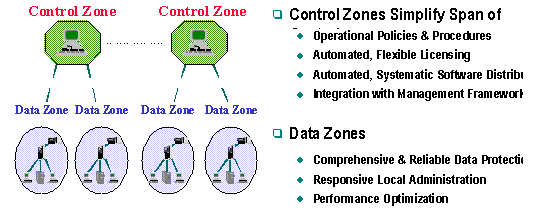
|
Figure 2.
TheControl Zone and Data ZoneThe first concept introduces the term data zone. A data zone is the boundary of storage servers, and desktop equipment managed by a single storage management server. It encompasses customer data, associated control or indexing data, tape devices, and a built-in administrative function. Its features include compactness and reliability.
Figure 3 is a representation of a data zone. There is one central storage management server in this configuration. This server contains all the control and index information about all the data that is managed in this data zone. The storage management server is connected to a local storage device that will hold all this information, as well as any data that is backed up to this device. Attached to the storage management server are its clients (machines on the network that back up their data to the main storage management server.
|
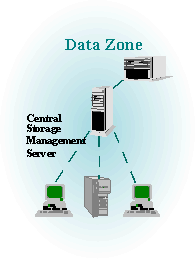 |
Figure 3. Data Zone:
Boundary of Servers and Desktops Managed by a Single Storage Management ServerStorage nodes are added to data zones to add greater performance and failover capabilities. A storage node is a system that uses local devices for data protection, but relies upon the central storage management server for index and control information. Figure 4, below, shows a storage node added to the central storage management server within the data zone
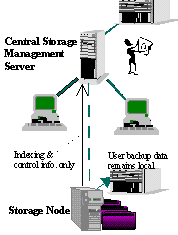
|
A Storage Node is a secondary storage server deployed within a data zone for performance or span-of-control reasons. |
Figure 4.
Storage NodeThe benefits of adding a storage node are numerous, and include:
For example, a company has a small site not located in the main headquarters building, but in another small building on campus. Employees at this site generate large amounts of mission-critical data. Because of availability needs, the backup window is very small. Without a storage node solution, the company would need to consider additional server and personnel resources to manage this site. But by deploying a storage node at this site, the company can utilize one of the central storage management servers to perform the backup. Using a locally attached storage device, data remains protected, at that site. Only control and indexing information is sent to the central storage management server. In addition, the dedicated storage device for local backup of this mission-critical data increases performance.
The addition of storage nodes to the data zone structure brings many benefits to the local network. With storage nodes, small remote sites can still be managed centrally at the data center, without the need for additional personnel. When high performance and high reliability are needed, local attached storage devices can provide this benefit.
Finally, we will discuss the overall structure of the enterprise architecture, the control zone. A control zone is a collection of data zones that are centrally managed with global policies. Control zones are established for the purpose of centralized administration and policy management. The number of data zones within a control zone varies (Figure 5).
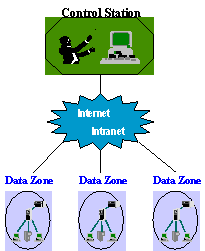 |
Enhances, not eliminates, data zone administration. |
Figure 5.
Collection of Data Zones Managed by a Single GEMS Control Station.The benefits of a control zone include:
Architecture Benefits Analysis
Finally, it is worthwhile to take a look at the enterprise storage management requirements that we outlined in the previous section, and see how this unique architecture meets these needs.
The Control Zone / Data Zone architecture supports this trend in enterprise storage management by offering centralized management of the overall company network (at a central location or control zone) and localized protection of data (i.e., the data does not span a network, but remains local within the data zone)
A dedicated local storage device, and the fact that the data does not need to transverse a network, greatly increases performance, offering the ability to accommodate increasingly shorter backup windows.
Again, storage nodes provide this much-needed benefit. A dedicated server and a locally attached storage device increase performance. Storage nodes also provide failover coverage, which is critical to this type of environment. Additionally, the storage management architecture should support the backup, at the file level, of these mission-critical applications.
In enterprise environments, it is critical that media management is automated, especially for online, 7x24 mission critical applications, eliminating the need for 24 hour staffing to manage the backup process. Automation also makes it easier to clone or archive, and especially recover critical data. The system knows exactly where the data that is being requested resides. It is also important that this automated media management operates across a heterogeneous network, transparently.
As mentioned before, it is important for a storage management product to not only support, but interoperate across all major computing platforms.
Often, backup is the main focus of storage management plans. But in the end, it is the recovery policy and the ability of the storage management product to speedily perform the recovery of critical data, across all platform, that is most important.
Case Study
Introduction
The following case study is a concrete example of the benefits of this architecture and how it can be deployed.
As discussed in this paper, today's expanding enterprises are facing a multitude of storage management challenges. Meeting the needs of distributed department and client/server networks, as well as smaller replicated networks (some being at remote sites) is a top priority. In the previous sections, we presented an architecture that will meet the needs of the enterprise. Now we will support the theoretical presentation with a case study depicting a typical enterprise environment, and showing the architectural and product considerations of a total enterprise storage management solution.
Background Information
Third Liberty Bank is a growing financial institution. As with many companies, Third Liberty Bank is now beginning to evaluate their storage management plan after suffering a business-threatening loss of data in a recent fire. Their evaluation takes both current and future needs into consideration, since they have plans to expand branch facilities in the near future.
Currently, Third Liberty Bank's headquarters is a 2-level, 10,000 square foot facility. This location (Figure 6) houses Third Liberty's Customer Service, Accounting / Payroll, Sales and Marketing, as well as most of their main financial offerings. The first offering is retail banking, which includes consumer checking, ATM, savings, etc. Third Liberty also offers money market investing. Their real estate segment deals with commercial and private property mortgages, and finally, their trust segment contains IRAs, trust, 401Ks, etc.
In addition to their main headquarters, Third Liberty also has two remote branches where mainly retail banking transactions occur. An international office houses all of the four financial offerings, retail, investment, real estate, and trust as well as a local customer service function.
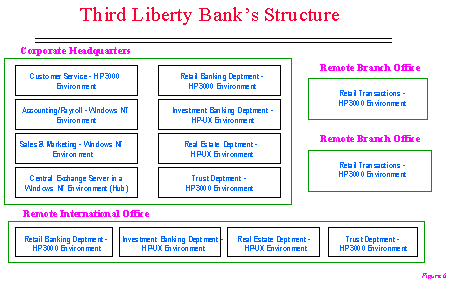
Figure 6. Third Liberty Bank’s Departmental Structure
Taking a closer look at each of these environments, we find that the headquarters customer service department is managed by an HP 3000 environment. This machine is necessary for mission-critical customer data, including order entry data, order processing transaction data, visa card information, etc. If a customer calls the bank to report a lost or stolen VISA card, the bank needs to ensure that they can access the relevant data immediately, and prevent any further transactions by cancelling the number.
Accounting / payroll, sales and marketing, and the bank's central exchange mail server all run on Windows NT systems. The bank found that the applications found in this environment meet the ongoing needs of the company personnel. The retail banking branch of the bank is also run in an HP 3000 environment, for the same reasons that customer service deploys this model; customers need immediate access to their current balances, and the bank needs access to this information to verify that customers have sufficient funds to perform requested transactions.
The investment banking branch of the bank is managed by HP-UX servers. These servers provide reliable, quick transactions necessary for investment banking. The real estate branch is also run on HP-UX systems for the same reasons. With real estate, data is not needed on a 7x24 real-time, immediate basis; yet, the amount of data is large, with many number-intensive applications in use. The bank felt that HP-UX servers would provide a robust solution for this environment, but an HP 3000 would not be needed. Finally, the trust department is managed in a Windows NT environment. This environment provides the necessary financial applications, as well as the long-term computing strategy that meets the Trust department's needs.
Third Liberty Bank's remote branches offer retail banking services to consumers. Their international site duplicates many of the function of the US-based headquarters, except for accounting/payroll and sales and marketing. For these needs, the international site relies on the main branch headquarters.
Storage management issues to be addressed
With the bank's current storage management scheme, much of the mission-critical backup is at the department level. With this scenario, there are no consistent data management policies. For instance, data in some departments is backed up once a week; in other departments, it is backed up daily because the backup window was wider. In this situation, recovery could not be done consistently. In addition, if a server failed, the servers in other departments could not be used to recover the data. This occurred in the case of the recent fire. Critical data was lost from the retail banking department. As with all financial institutions, government regulations require that certain types of this data be stored offsite. Although the bank was able to recover much data from offsite locations, they were still missing some transaction data from the day of the fire.
With the bank's current backup system, additional personnel is required to support the chosen tape storage solution. They are now looking at an automated media management solution utilizing libraries across all environments. This feature would benefit all departments, and especially the mission-critical, 7x24 environments running on the HP 3000s. Another problem the bank encounters with their current backup solution is the sharing of data between branches. Government regulations do not allow data to be shared openly. However, the sales and marketing group request customer information from one branch that they could use for direct marketing of services to another branch. The bank would benefit from a cloning solution that would allow only certain customer data to be cloned to a different location for sales and marketing's use.
Solution
First Liberty discovered many needs that their current backup solution was not addressing. Now, let's take a look at the solution that the bank chose, and see how it meets their current and future storage management needs. Figure 7 shows Third Liberty Bank's new storage management architecture.
Figure 7. Third Liberty Bank’s Storage Management Architecture (viewed from a data zone level)
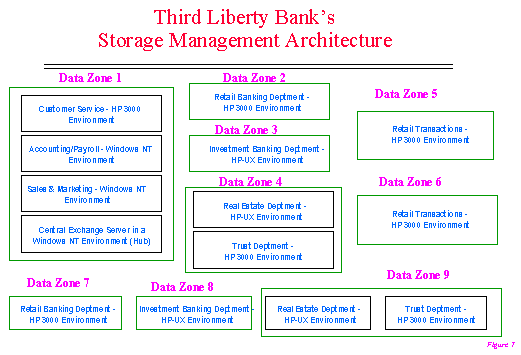
The bank divided their environments into data zones, based on their specific storage management needs. Further, Figure 8 shows each data zone with its own dedicated central storage management server. And finally, it depicts the entire control zone environment, where storage management policies can be managed from a given central location, yet specific data can be managed locally, to provide increased data protection
Figure 8. Third Liberty Bank’s Storage Management Architecture (Depicting data zones within a control zone)
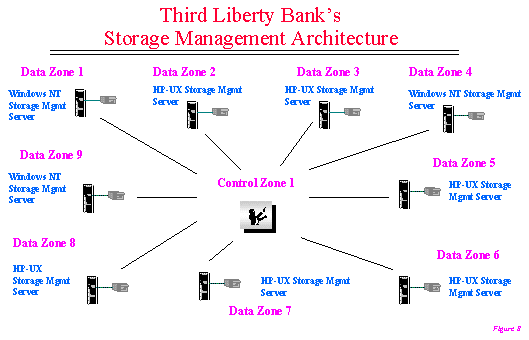
Looking at the data zone environment, data zone 1 encompasses some of the standard departments within Third Liberty that have similar data management needs. These departments include customer service, accounting/payroll, sales and marketing, and the central exchange server. A Windows NT central storage management server is managing this data zone. For the most part, the data within this area would have similar storage management recovery needs, so policies can be set within similar boundaries.
Figure 9. Third Liberty Bank’s Data Zone 2 Architecture
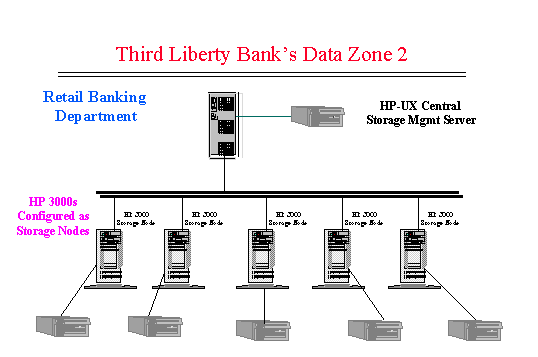
Data zone 2 (Figure 9) encompasses the retail banking department of Third Liberty, and uses an HP-UX central storage management server. This department was grouped into a data zone due to its special storage management needs. As we described, the retail banking group operates in a mission-critical HP 3000 environment. Several of these HP 3000s are configured as a storage node within this data zone for the following reasons:
Data zone 3, configured for investment banking, another area of the company where the data needs to be highly available, has a similar storage management architecture as data zone 2 (i.e., deploying storage nodes for the same reasons), except the storage nodes are HP-UX servers instead of HP 3000s. Data zone 4 deploys a Windows NT central storage management server. Data within this data zone, although very important, is not quite as mission-critical as with the previous departments, because customers are usually not making daily transactions to accounts and information turnaround doesn't need to be instantaneous.
Data zone 5 and 6 comprise Third Liberty Bank's remote retail banking transactions. These environments operate in a mission-critical HP 3000 environment, with HP-UX servers being deployed as the central storage management server within a replicated workgroup environment. Again, as with the configuration of data zones 3 and 4, HP 3000s are deployed as storage nodes within this data zone for failover, local performance and automated media management benefits.
Finally, we need to look at Third Liberty Bank's international site. As we mentioned previously, many parts of the international office are replicated from Third Liberty Bank's headquarters. So it was determined that this storage management architecture could be duplicated as well. The only exception to this is data zone 7, which also contains a local customer service department. But since customer service operates in an HP 3000 environment with of the same needs the retail department has, it made more sense to include it in data zone 7, rather than creating its own unique data zone.
Figure 8 clearly shows how easy it is to manage this overall architecture from a control zone. Third Liberty is constantly expanding driving the need to set policies at a higher level, and let local departments manage specific data management. It is very clear how easy it would be for Third Liberty to expand their operations with another data zone, large or small, and easily add it to the centrally managed control zone. It is also evident that this architecture can consistently grow and change as Third Liberty does, within this fast moving, highly competitive, enterprise environment in which companies operate today.
Conclusion
Now, if a disaster, such as Third Liberty Bank's recent fire, were to occur, disaster recovery would not only be possible, but very manageable. Let's look at some of the ways Third Liberty has benefited:
These are just a few of the many benefits Third Liberty has realized with this new storage management architecture. The bank is now poised to handle future data growth and its accompanying storage challenges.
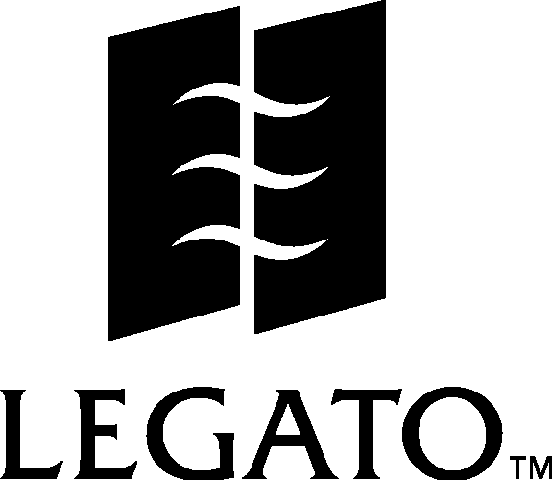
3210 Porter Drive
Palo Alto, CA 94304
650-812-6000
650-812-6032 fax
www.legato.com